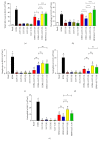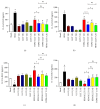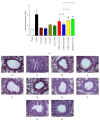Effect of Low-Level Laser Therapy (LLLT) in Pulmonary Inflammation in Asthma Induced by House Dust Mite (HDM): Dosimetry Study
- PMID: 31015955
- PMCID: PMC6448342
- DOI: 10.1155/2019/3945496
Effect of Low-Level Laser Therapy (LLLT) in Pulmonary Inflammation in Asthma Induced by House Dust Mite (HDM): Dosimetry Study
Abstract
Asthma is characterized by chronic inflammation in the airways. Several models have been proposed for the discovery of new therapies. Low-Level Laser Therapy (LLLT) is relatively new and effective, very low cost, with no side effects. However, there is still no consensus on the optimal dose to be used. In this sense, the objective of the present study was to evaluate the best dose in an experimental model of asthma induced by House Dust Mite (HDM). Balb/c mice received administration of 100 ug/animal HDM and LLLT applications (diode laser: 660 nm, 100 mW and four different energies 1J, 3J, 5J, and 7.5J) for 16 days. After 24 hours, we studied inflammatory, functional, and structural parameters. The results showed that LBI was able to modulate the pulmonary inflammation observed by reducing the number of cells in Bronchoalveolar Lavage Fluid (BALF) as well as reducing the percentage of neutrophils, eosinophils and T lymphocytes. On the other hand, LLLT increased the level of IL-10 and reduced levels of IL-4, IL-5 and IL-13 in BALF. LLLT was able to reduce the production of mucus, peribronchial eosinophils, collagen deposition, bronchoconstriction index, and bronchial and muscular thickening in the airways. We concluded that the use of LLLT in the treatment of chronic inflammation of the airways attenuated the inflammatory process and functional and structural parameters. We emphasize, in general, that the 1J and 3J laser presented better results. Thus, photobiomodulation may be considered a promising tool for the treatment of chronic pulmonary allergic inflammation observed in asthma.
Figures







Similar articles
-
The interleukin-33 receptor ST2 is important for the development of peripheral airway hyperresponsiveness and inflammation in a house dust mite mouse model of asthma.Clin Exp Allergy. 2016 Mar;46(3):479-90. doi: 10.1111/cea.12683. Clin Exp Allergy. 2016. PMID: 26609909
-
The development of allergic inflammation in a murine house dust mite asthma model is suppressed by synbiotic mixtures of non-digestible oligosaccharides and Bifidobacterium breve M-16V.Eur J Nutr. 2016 Apr;55(3):1141-51. doi: 10.1007/s00394-015-0928-8. Epub 2015 May 24. Eur J Nutr. 2016. PMID: 26003185 Free PMC article.
-
Complement factor C5 inhibition reduces type 2 responses without affecting group 2 innate lymphoid cells in a house dust mite induced murine asthma model.Respir Res. 2019 Jul 24;20(1):165. doi: 10.1186/s12931-019-1136-5. Respir Res. 2019. PMID: 31340811 Free PMC article.
-
Low-Level Laser Therapy for Rheumatoid Arthritis: A Review of Experimental Approaches.J Lasers Med Sci. 2022 Dec 10;13:e62. doi: 10.34172/jlms.2022.62. eCollection 2022. J Lasers Med Sci. 2022. PMID: 37041796 Free PMC article. Review.
-
The Role of Low-Level Laser Therapy in the Treatment of Multiple Sclerosis: A Review Study.J Lasers Med Sci. 2021 Dec 28;12:e88. doi: 10.34172/jlms.2021.88. eCollection 2021. J Lasers Med Sci. 2021. PMID: 35155173 Free PMC article. Review.
Cited by
-
Effects of photobiomodulation as an adjunctive treatment in chronic obstructive pulmonary disease: a narrative review.Lasers Med Sci. 2023 Jan 28;38(1):56. doi: 10.1007/s10103-022-03661-6. Lasers Med Sci. 2023. PMID: 36707463 Free PMC article. Review.
-
The Efficacy of Low-Level Laser Therapy on the Healing of Oral Wounds: A Systematic Review.Cureus. 2024 Oct 4;16(10):e70832. doi: 10.7759/cureus.70832. eCollection 2024 Oct. Cureus. 2024. PMID: 39493098 Free PMC article. Review.
-
Light-based technologies for management of COVID-19 pandemic crisis.J Photochem Photobiol B. 2020 Nov;212:111999. doi: 10.1016/j.jphotobiol.2020.111999. Epub 2020 Aug 19. J Photochem Photobiol B. 2020. PMID: 32855026 Free PMC article. Review.
-
Photobiomodulation Therapy Restores IL-10 Secretion in a Murine Model of Chronic Asthma: Relevance to the Population of CD4+CD25+Foxp3+ Cells in Lung.Front Immunol. 2022 Feb 2;12:789426. doi: 10.3389/fimmu.2021.789426. eCollection 2021. Front Immunol. 2022. PMID: 35185864 Free PMC article.
References
-
- GINA. Global Initiative for Asthma. Strategy for Asthma management and prevention, 2018, http://www.ginaasthma.org.
-
- Mikhailov V. A., Aleksandrova O., Gol'dina E. M. The immunomodulating action of low-energy laser radiation in the treatment of bronchial asthma. Voprosy Kurortologii, Fizioterapii, I Lechebnoĭ Fizicheskoĭ Kultury. 1998;4:23–25. - PubMed
-
- Carvalho J. L., Britto A., de Oliveira A. P. L., et al. Beneficial effect of low-level laser therapy in acute lung injury after i-I/R is dependent on the secretion of IL-10 and independent of the TLR/MyD88 signaling. Lasers in Medical Science. 2017;32(2):305–315. doi: 10.1007/s10103-016-2115-4. - DOI - PubMed
LinkOut - more resources
Full Text Sources
Other Literature Sources
Medical

